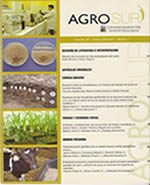Variación de la biodisponibilidad de los herbicidas metsulfuron - metil y triasulfuron bajo distintas condiciones de encalado en dos suelos volcánicos del sur de Chile
Contenido principal del artículo
Resumen
El uso conjunto de herbicidas sulfonilureas con enmiendas calcáreas es una práctica habitual en suelos ácidos derivados de cenizas volcánicas, especialmente en cultivos de cereales. El objetivo de este estudio fue determinar, a través de bioensayos, la biodisponiblidad de los herbicidas metsulfuron-metil y triasulfuron por efecto del encalado en dos suelos derivados de cenizas volcánicas. Los suelos utilizados fueron un Hapludand serie Malihue y un Paleohumult serie Fresia. La especie indicadora fue arveja (Pisum sativum L.), sembrada en macetas con ambos suelos y bajo cuatro niveles de encalado (equivalente a 0; 1,9; 3,7 y 7,4 t ha-1 de Ca(OH)2) y 11 concentraciones de herbicidas. En cada bioensayo se incluyó un tratamiento testigo con sustrato no adsortivo con cuarzo sin encalado. A los 8 días de aplicados los herbicidas se midió el largo radical de la especie indicadora y los valores obtenidos fueron ajustados a un modelo no-lineal, determinándose la dosis que inhibió el 50% del desarrollo radical (IC50) en cada tratamiento. La biodisponibilidad de cada herbicida correspondió al cuociente entre el IC50 obtenido en el sustrato cuarzo y el IC50 obtenido en cada tratamiento. Los resultados demostraron que la adsorción de metsulfuron-metil y de triasulfuron disminuyó a medida que aumentó la dosis de encalado, aumentando su biodisponibilidad relativa en ambos suelos. La adsorción de triasulfuron con el incremento de las aplicaciones de cal fue inferior a la de metsulfuron-metil en términos cuantitativos, pero mayor en términos relativos. Estos resultados se corroboraron al examinar los coeficientes de adsorción (Kd).

